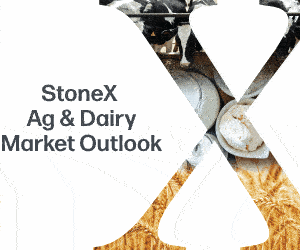 |
|||

|
 |

|
|
Guest Columns
Perspective:
WCMA
Relative calm surrounds Class III and IV reforms
John Umhoefer
John Umhoefer is executive director of the Wisconsin Cheese Makers Association. He contributes this column monthly for Cheese Market News®.
Silent as a shrug, the dairy industry appears quietly accepting of the changes to milk pricing formulas for Class III and IV milk in the July 1 recommended decision from USDA.
The changes to milk composition factors and make allowances are of greatest interest in federal milk marketing orders with strong production of cheese, butter and dried dairy products. But changes proposed for Class I (bottled) milk pricing impact these cheese and butter areas, too, with the anticipated net effect of lower farm milk prices where manufactured products dominate.
The Dairy Markets and Policy Center at the University of Wisconsin has rolled out excellent information letters about the recent recommended decision from USDA. Since Wisconsin Cheese Makers Association (WCMA) and International Dairy Foods Association (IDFA) requested a hearing in March 2023 to amend make allowances in federal order milk price formulas, USDA has impressively managed the bulky process of notices, hearing and decisions to execute national price reform.
With the release of a 332-page recommended decision from USDA’s Agricultural Marketing Service on July 1, the cake is nearly baked. Industry can comment on USDA’s decision until Sept. 13, and USDA will issue a final decision by mid-November. Producers in each federal milk marketing order then vote to accept or reject the amendments to their order, with the dramatic implication of terminating the entire order if the amendments are rejected.
The Dairy Markets and Policy Center looked at the implications of producers voting to terminate the Upper Midwest Order 30, but first it’s important to understand what USDA decided for Class III and IV markets.
• Make allowances rise
It is gratifying to see that real cost data from the dairy industry, gathered by Dr. Mark Stephenson and forming the backbone of proposals from WCMA and IDFA, carried the day. Dr. Stephenson’s 2021 nationwide dairy plant cost survey, requested by USDA, and his similar 2023 survey, requested by IDFA and WCMA, were considered by USDA. The agency also studied California manufacturing cost survey data from 2004-2016 and Dr. Bill Schiek’s analysis of that audited California data in which he projected California dairy product production costs beyond 2016.
USDA’s recommended decision selects 25.04 cents as the new make allowance for Cheddar cheese in milk pricing formulas — 5.01 cents higher than the current value, but 3.36 cents lower than WCMA and IDFA sought.
USDA proposes to raise the make allowance for dry whey 6.62 cents to 26.53 cents, lower than the 31.72 cents requested by WCMA and IDFA.
Butter is offered a new 22.57-cent make allowance by USDA, up 5.42 cents and lower than the 27.85 cents sought by WCMA and IDFA.
USDA also went to the middle with nonfat dry milk, lifting the make allowance 5.9 cents to 22.68 cents, but coming in under the 27.16 cents requested by the associations.
• Milk composition and butterfat recovery factors
Milk price formulas in federal orders use set values for the amount of protein, other solids and nonfat solids in milk. The recommended decision raises the set values for milk composition from 3.1% protein in milk to 3.3%, tweaks other solids from 5.9% to 6% and raises nonfat solids from 9% to 9.3%.
USDA also decided that Cheddar cheese retains 91% butterfat, rather than the current 90% level used in the Class III price formula, which moves the butterfat yield factor in the cheese price formula from 1.572 to 1.589.
Based on these changes, the Dairy Markets and Policy Center states: “The impacts of these changes on prices paid for farm milk will be positive for markets with considerable Class I utilization and negative for markets with considerable Class III utilization.”
That conclusion about lower milk prices in cheese-rich areas like Order 30 likely spurred the authors, Dr. Charles Nicholson and Dr. Mark Stephenson, to draft the Information Letter: “Potential Implications of the Termination of Order 30 for Farm Milk Prices.”
At the core of this paper, the authors anticipate that if dairy producers vote to terminate Order 30, milk pricing may evolve to reflect pricing seen in the unregulated, cheese-centric area encompassing Idaho and Utah. This western area has no federal order, but prices there reflect the Class III milk price, they note, which would imply that Order 30 prices would drop to Class III, losing the value of the producer price differential (which averaged 30 cents per hundredweight during 2022 and 2023).
Would nearby orders, such as Central Order 32 or Mideast Order 33, provide a new home for milk if Order 30 was terminated? Nicholson and Stephenson conclude that the rules governing these federal orders — from delivery requirements to required “qualifying” shipments, and from diversion limits to cost of shipping milk — would significantly constrain the amount of milk traveling from Wisconsin or Minnesota to these nearby federal orders.
While Class I reforms proposed by USDA have stirred up considerable acrimony, changes for Class III and IV milk price formulas appear to have been received with quiet affirmation.
CMN
The views expressed by CMN’s guest columnists are their own opinions and do not necessarily reflect those of Cheese Market News®.
| CMN article search |

|
© 2025 Cheese Market News • Quarne Publishing, LLC • Legal Information • Online Privacy Policy • Terms and Conditions
Cheese Market News • Business/Advertising Office: P.O. Box 628254 • Middleton, WI 53562 • 608/831-6002
Cheese Market News • Editorial Office: 5315 Wall Street, Suite 100 • Madison, WI 53718 • 608/288-9090